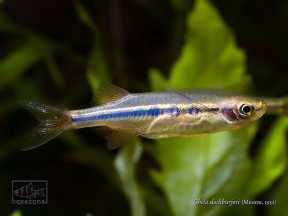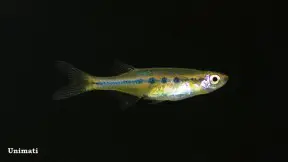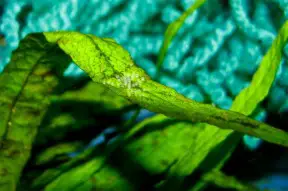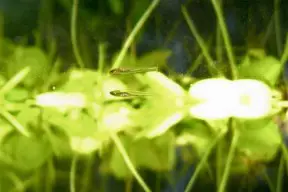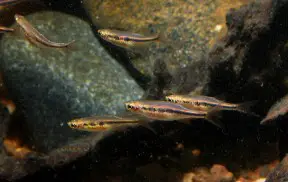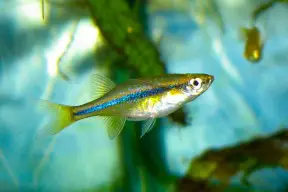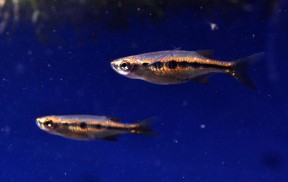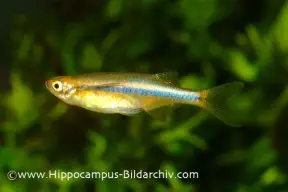Laubuka dadiburjori
Dadio
SynonymsTop ↑
Laubuca dadiburjori Menon, 1952; Chela dadiburjori (Menon, 1952)
Etymology
Laubuka: from Layubuka, a vernacular Bengali name for L. laubuca, the type species of the genus.
dadiburjori: named in honour of Bombay aquarist Sam J. Dadiburjor, who collected, spawned and “brought this interesting fish to the notice of science”.
Classification
Order: Cypriniformes Family: Cyprinidae
Distribution
Endemic to southern India with records from the states of Goa, Karnataka, Kerala, and Tamil Nadu, including the rivers Meenachil, Bharatapuzha, Chalakkudy, and Sita.
Type locality is ‘Cochin, Kerala, India’.
Habitat
Inhabits small tributary streams and freshwater pools, and is typically associated with dense riparian or aquatic vegetation.
Maximum Standard Length
20 – 30 mm.
Aquarium SizeTop ↑
An aquarium with base dimensions of 90 ∗ 30 cm or equivalent should be the smallest considered.
Maintenance
Should ideally be maintained in a planted set-up with some water movement, with a layer of vegetation covering at least part of the surface.
Some clumps of Taxiphyllum or similar would be a useful addition as they will provide a source of micro-organisms upon which both fry and adults can feed, and they may also be used for egg deposition. An air-powered sponge-type filter unit is best and should be matured before the fish are added.
Water Conditions
Temperature: 20 – 24 °C
pH: 6.0 – 7.5
Hardness: 36 – 179 ppm
Diet
Likely to feed on small invertebrates and other zooplankton in nature. In the aquarium it will accept dried foods of a suitable size but should also be offered meals of small live or frozen fare such as Daphnia, Artemia, grindal worms and suchlike.
Behaviour and CompatibilityTop ↑
This species is very peaceful and places no special demands in terms of water chemistry thus it can be combined with many other species. As always when selecting a compatible community of fish thorough research is essential, and its small adult size must be a consideration.
It’s a schooling fish by nature and should be kept in a group of at least 8-10 specimens. Maintaining decent numbers will not only make the fish less nervous but result in a more effective, natural-looking display.
Sexual Dimorphism
Sexually mature females are deeper-bodied and tend to grow slightly larger than males.
Reproduction
An egg-scattering spawner that does not exhibit parental care.
If the fish are in good condition they will spawn often and in a densely-planted, mature aquarium it’s possible that small numbers of fry may start to appear without intervention.
However if you want to increase the yield of fry a slightly more controlled approach is recommended; males tend to choose plant leaves or similar near the water surface as spawning sites therefore providing some suitably arranged décor is the first step. This can be done in the main tank or separately, as you prefer.
When the fish spawn the leaf holding the leaves is removed and placed into a separate container with some water from the aquarium it came from and a few drops of fungicide. An airline set to bubble gently should also be added.
Fertile eggs hatch in 2-3 days, and the fry become free swimming in a further 4-5 days. At this point they should be offered an infusoria-grade food, until large enough to accept Artemia nauplii and such like.
NotesTop ↑
L. dadiburjori has also been marketed as ‘Burjor’s brilliance’, ‘orange chela’, and ‘orange hatchetfish’ in the aquarium trade.
It can be distinguished from other members of the genus by the following characters: lateral line absent or perforating only 2-5 scales; pharyngeal teeth hooked; body size small, not exceeding 30 mm SL; body depth less than 25 % SL; colour pattern comprising a dark bluish lateral stripe extending from the eye to the caudal peduncle, typically, but not always, forming 2-5 circular spots along its length.
The generic name tended to be spelled ‘Laubuca‘ for a number of years, but it is now established that Bleeker used ‘Laubuka‘ first, therefore this spelling has priority.
Among other cyprinids Laubuka species are closely related to the genera Chela, Malayochela, and Devario according to recent phylogentic research, which also supports the splitting of the fomerly much larger Chela grouping into Chela, Malayochela, and Laubuka. There is also a suggestion that L. dadiburjori is not a direct relative of other Laubuka species and may warrant placement in its own genus.
References
- Menon, A. G. K., 1952 - Records of the Indian Museum (Calcutta) v. 49 (pt 1): 1-4
Notes on fishes in the Indian Museum. XLVI. On a new fish of the genus Laubuca from Cochin. - Fang, F., M. Norén, T.-Y. Liao, M. Källersjö and S. O. Kullander, 2009 - Zoologica Scripta 38(3): 237-256
Molecular phylogenetic interrelationships of the south Asian cyprinid genera Danio, Devario and Microrasbora (Teleostei, Cyprinidae, Danioninae). - Kulabtong, S., S. Suksri and C. Nonpayom, 2012 - Biodiversity Journal 3(1): 93-95
A new species of genus Laubuca Bleeker, 1860 cyprinid fish from Bangladesh (Cypriniformes, Cyprinidae). - Pethiyagoda, R., M. Kottelat, A. Silva, K. Maduwage and M. Meegaskumbura, 2008 - Ichthyological Exploration of Freshwaters 19(1): 7-26
A review of the genus Laubuca in Sri Lanka, with description of three new species (Teleostei: Cyprinidae). - Ramsay, G., 2011 - Available online at: http://fcas.wordpress.com/2011/10/26/laubuca-dadiburjori-dadio/
Laubuca dadiburjori – Dadio
